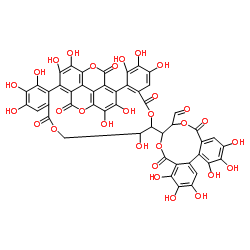65995-63-3
| Name | Punicalagin |
|---|---|
| Synonyms |
pulchinenoside b4(rg)
1,2,3,11,12,13-Hexahydroxy-5,10-dioxo-8-[3,4,5,11,17,18,19,22,23,34,35-undecahydroxy-8,14,26,31-tetraoxo-9,13,25,32-tetraoxaheptacyclo[25.8.0.0.0.0.0.0]pentatriaconta- 1(35),2,4,6,15,17,19,21,23,27,29,33-dodecaen-10-yl]-5,7,8,10-tetrahydrodibenzo[f,h][1,4]dioxecine-7-carbaldehyde |
| Description | Punicalagin is a polyphenol ingredient isolated from Pomegranate (Punica granatum L.) or the leaves of Terminalia catappa L.. Punicalagin is a anti-hepatitis B virus (HBV) agent and has antioxidant, anti-inflammatory, and anticancer effects[1][2][3]. |
|---|---|
| Related Catalog | |
| In Vitro | Punicalagin (100 mg/ml) induces apoptosis in HT-29, HCT116 colon cells[1]. |
| In Vivo | Punicalagin (10 mg/kg) inhibits the edema rate of 58.15% in rats[2]. |
| References |
| Density | 2.1±0.1 g/cm3 |
|---|---|
| Molecular Formula | C48H28O30 |
| Molecular Weight | 1084.718 |
| Exact Mass | 1084.066528 |
| PSA | 518.76000 |
| LogP | 2.36 |
| Appearance | faint yellow to dark yellow |
| Index of Refraction | 1.893 |
| Storage condition | 2-8°C |
| Water Solubility | methanol: soluble5mg/mL, clear |


